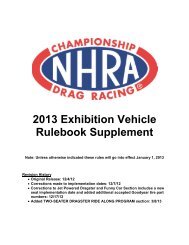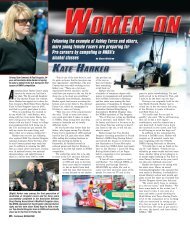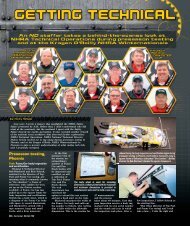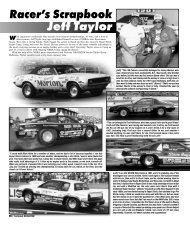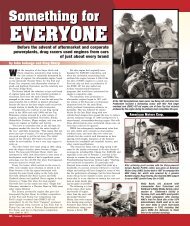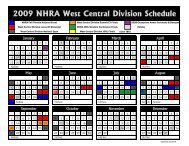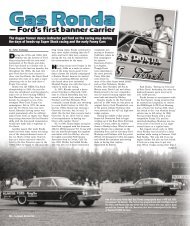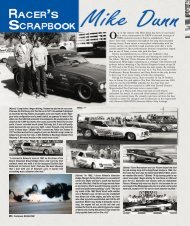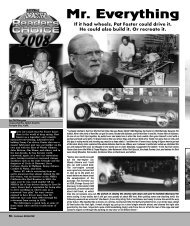Top 10 Top Fuel Innovations - NHRA.com
Top 10 Top Fuel Innovations - NHRA.com
Top 10 Top Fuel Innovations - NHRA.com
- No tags were found...
You also want an ePaper? Increase the reach of your titles
YUMPU automatically turns print PDFs into web optimized ePapers that Google loves.
<strong>Top</strong> <strong>10</strong> <strong>Top</strong> <strong>Fuel</strong> <strong>Innovations</strong>A collection of the most important technological advancements that enhancedthe performance of nitro-burning rails and that are still used todayhis is the first in a series of articles in which we will list themost significant innovations in each <strong>NHRA</strong> Pro class. One of therequirements in selecting these breakthrough designs is that the ideaor concept must still be employed. Ideas such as streamlined bodies,which have appeared from time to time but have never been used on apermanent basis, were accordingly not included.Because of the similarities between <strong>Top</strong> <strong>Fuel</strong> and Funny Carengines, some of the examples in this story began in the FunnyCar ranks but were quickly adapted to <strong>Top</strong> <strong>Fuel</strong> applications.Our forth<strong>com</strong>ing segment on Funny Car innovations will dealprimarily with the aerodynamic improvements of that full-bodiedcategory.by John Jodauga1. First drag racing slicksDon Garlits has always claimed that drag racers had the horsepower to gomore than 200 mph as early as 1957, but they were unable to do so until atire good enough to transfer that power to the ground became available in1964. Garlits’ claims are amply backed up by photos from the late 1950s,which show that <strong>Top</strong> <strong>Fuel</strong>ers were racing on recapped tires only seveninches wide. It wasn’t until 1957, when Marv Rifchin, whose M&H Tire Co.produced circle-track racing tires, was invited to a race in Florida that thefirst drag racing rear slick was invented. Relying heavily on feedback fromracers such as Garlits, Rifchin began making tires specifically for dragracing, and his M&H 8.20x15 model helped Garlits run in excess of 180mph in a car equipped with carburetors. Garlits later used a pair of M&H11x16 tires for his ground-breaking 201.34-mph national record run, the firstpass in excess of 200 mph, in Great Meadows, N.J.Goodyear entered the drag racing slick market in1964, which led to an accelerated curve in the advancementof tire technology, resulting in quicker elapsedtimes and faster speeds at an unprecedented pace.Don Garlits still calls the drag racing slick the most important<strong>com</strong>ponent of any quarter-mile vehicle, pointing out that “allof the horsepower in the world won’t do you a bit of goodunless you can put it to the ground.”3. Slipper clutches/wrinkle-wall tiresThis is one <strong>com</strong>bination that derived from technology accidentally discovered and anew trick employed by <strong>Top</strong> <strong>Fuel</strong>’s counterparts in the Factory Experimental doorslammerrank. Through 1966, <strong>Top</strong> <strong>Fuel</strong> racers employed a controlled tire spin throughoutthe run that left a trail of smoke all the way to the finish line. Then one day in early1967, as legend has it, a <strong>Top</strong> <strong>Fuel</strong> team went quicker than ever before when theyaccidentally loosened their clutch instead of tightening it, as intended. Slipping theclutch off the line eliminated engine bog, so spinning the tires was no longernecessary, and elapsed times immediately began to drop. To further enhance this newapproach, nitro racers began to notice how the top doorslammer factory rides, whichwere limited to <strong>10</strong>-inch tires in A/FX and seven-inch dimensions in Super Stock, wereusing tires with thinner side walls and lower tire pressure, which would wrinkle thesides of the tires to create a longer footprint.Goodyear responded with atwo-ply wall to create similarbenefits for the fuelers. <strong>Top</strong><strong>Fuel</strong> purists warned thatdoing away with the tracklongtire smoke would turnoff fans, but when the dragstersbroke the six-secondbarrier in mid-1967, interestgrew to even greater heights.The introduction ofslipper clutches andwrinkle-wall tires inearly 1967 eliminatedthe smoking tirelaunch and propelled<strong>Top</strong> <strong>Fuel</strong>ers into thesix-second zone.2. Zoomie headersThe first drag racing headers were simple straight pipes(often referred to as weed burners) that were designed toallow exhaust gasses to exit from the <strong>com</strong>bustion chamber asquickly as possible. But in 1964, racers — Frank Cannon isgenerally considered to be the first — began to realize thatthe tremendous pressure emitted from the headers could beused to aid traction — thus the creation of zoomie headers,which point skyward in an effort to push the car down foradded traction. The significance of the downforce supplied byzoomie headers was illustrated by Dale Armstrong, who said,“We were always looking for ways to lighten up Kenny Bernstein’sBudweiser King car, and one day I decided to rifle-drillall of the header bolts toremove just a few gramsof weight. Not long afterthat, on one of Kenny’sruns in Phoenix, theheader bolts on the rightside sheared and thewhole bank of headerscame off. The lack ofdownforce on that sideunloaded the tire, andKenny’s car, which was inthe left lane, made animmediate hard turn tothe right and almost hitthe guardwall on theright lane. Today’s <strong>Top</strong><strong>Fuel</strong> cars wouldn’t be ableto get off the line withoutgoing up in smoke.”With the instant hit of thethrottle, zoomie headers use thetremendous power of theexhaust to plant the tires duringthe launch, well before the carbuilds up enough speed for thewings to have a downforceeffect. Today’s .8-second 60-footclockings would not be possiblewithout zoomie headers.4. Don Garlits’ 1971 rear-engine dragsterPrior to 1971, several attempts had been made at creating a rear-engine dragster, and while anyof the early ideas looked good on paper, they failed to live up to expectations.After Don Garlits experienced a violent clutch explosion at Lions Drag Strip, he workedwith T.C. Lemmons and Connie Swingle to <strong>com</strong>e up with a design to put the volatile powerplantbehind him. After scoring a runner-up in its debut at a Lions event in early 1971,Garlits went on to be<strong>com</strong>e the first driver to win an <strong>NHRA</strong> national event with a rear-enginedragster at that year’s Winternationals. By the end of the season, Garlits’ new creation wasthe most dominant <strong>Top</strong> <strong>Fuel</strong> entry in the country, and the majority of his <strong>com</strong>petitors followedsuit by switching to rear-engine dragsters.5. Joe Amato’s 1984 ‘big-winged’ dragsterThe <strong>Top</strong> <strong>Fuel</strong> class was changed forever whenJoe Amato unloaded his radical “big-wing”dragster at the 1984 <strong>NHRA</strong> Gatornationals,where Amato won the event title and madethe first <strong>Top</strong> <strong>Fuel</strong> run in excess of 260 mph.The genesis of the large-wing configurationcame from Indy 500 driver and race carfabricator Eldon Rasmussen. Until the 1983season, <strong>Top</strong> <strong>Fuel</strong> wings were supported by 90-degree vertical struts that placed the wingdirectly over the struts’ mounting points.Arguably the most significant development in <strong>Top</strong> <strong>Fuel</strong>history, placing the fire-belching, oil-spewing enginebehind the driver not only prevented serious injuriesbut also extended the careers of several racers.Though this radical configuration is now22 years old, Amato’s 1984 big-wing dragsterhas served as the template for today’scontemporary <strong>Top</strong> <strong>Fuel</strong> chassis designs.Rasmussen told Amato’s crew chief Tim Richards that by placing the wing farther behindthe car, additional downforce leverage would be applied to the rear tires, especially at thetop end.70 ✦ National DRAGSTER
6. Aftermarket blocksand headsDrag racing wasmuch cheaper inthe days whenteams used earlymodel Hemi blocksand heads obtainedfrom junkyards, buttoday’s 4.4-secondruns at more than330 mph wouldhave never beenpossible if theaftermarket industryhadn’t createda line of blocks andheads dedicatedspecifically forquarter-mileapplications.Ed Donovan was the first to do so when he introducedthe first aluminum block — based on the 392-cidHemi and featuring replaceable steel liners — at the1971 <strong>NHRA</strong> Supernationals. Other manufacturers, suchas Keith Black, Milodon, and Joe Pisano, followed suitwith their aluminum blocks, but according to <strong>Top</strong> <strong>Fuel</strong>crew chief Alan Johnson, the biggest breakthrough wasthe creation of the Brodix TFX block, the first billetdesign to be forged from 6061 aluminum. Said Johnson,“The earlier cast-aluminum blocks had inherent propertiesthat were fairly weak. We couldn’t lean on the olderblocks like we do now with the new billet versions.”The same story is true for today’s aftermarket heads.Said Dale Armstrong, “When the first aluminum headscame out in the mid-1970s, many racers were reluctantto use them because they would act as a heat sink,which would lower <strong>com</strong>bustion-chamber temperaturesand drop cylinders.”But Pro Comp star and innovator Ken Veney decidedto solve this and other concerns by creating his firstpair of billet heads that were essentially hand carvedfrom a couple of pieces of scrap aluminum using aBridgeport machine. “When I made these heads,” saidVeney, “I also tried to solve many problems that wereinherent with the cast versions.” After Veney raised theFunny Car national speed record to 254.95 mph andtied the existing e.t. mark with his Corvette at the 1982U.S. Nationals, the apprehension to aluminum headsdisappeared almost as quickly as his record run, andbillet aluminum heads earned a permanent spot in theparts inventory of nitro-burning engines.7. Data-acquisition systemsFor years, drag racing <strong>com</strong>petitors took pride in their ability to enhanceperformance through the time-proven process of trail and error, and it wasn’tuntil drag racing entered the digital age with the introduction of the widelyused onboard data-recording system, the RacePak <strong>com</strong>puter, in 1985 that thesport really began to advance. Until then, crew chiefs and mechanics had torely primarily on driver feedback. This practice ended when Dale Armstrong,Kenny Bernstein’s Funny Car crew chief at the time, began talking with RonArmstrong (no relation) and Spencer Eisenbarth of Competition SystemsInc., which had already developed a multichannel system for race boats. In1984, the first RacePak system was installed on Kenny Bernstein’s FordTempo, which broke the 260-mph Funny Car barrier at that year’sGatornationals.The technology was made available to the general drag racing public oneyear later when Armstrong and Bernstein joined forces with Ray Alley todistribute the RacePak through their King Racing Components operation.Data-acquisition systems not only allow drivers to <strong>com</strong>pare their recollections of the run with hard,factual information, but the knowledge accumulated by the systems led to the creation of manytechnological advancements, most notably the clutch-management system.8. Clutch-managementsystemsOne of the first things that DaleArmstrong discovered with hisRacePak data-recording systemwas that the engine was consistentlyspinning at least <strong>10</strong> percentfaster than the clutch duringevery run. Said Armstrong, “Weran the two-speed Lenco transmissionsback then and could onlyrun so much weight on the clutcharms before they would overpowerthe tires and make them go up insmoke off the line. This kept theclutch from locking up fully in thelast half of the run.” He thenbegan working with Tony andLanny Migilizzi of L&T Clutchesto develop the first two-stageclutch. Today’s systems, which use11 to 12 stages, have hydraulicarms, which <strong>com</strong>e on gently, oneat a time. This is done with ahydraulic cylinder mounted behindthe throwout bearing, which ismoved back as pressure is bledfrom the cylinder through a seriesof jets and timers.Side-by-side racesin <strong>Top</strong> <strong>Fuel</strong> andFunny Car are farmore <strong>com</strong>monplacebecause of clutchmanagementsystems, whichallow crew chiefs toapply power to thetires in incrementalsegments to dealwith each track’sparticularconditions.9. Dual fuel pumps and ignitionsAdvancements in the technology of nitro-burning engines are so evolutionary that a breakthroughin one area may trigger advances in another closely related segment. Such was the casewith the development of dual-ignition and dual-fuel-pump systems.Said Dale Armstrong, “Dual fuel pumps came about because we had gotten to the point wherewe couldn’t get a single unit that was big enough. Ken Enderle was the first to point out to methat the rules allowed dual pumps. I installed a pair of pumps with a reconfigured arrangementthat used two barrel valves. The first barrel valve directed the fuel to eight new nozzles that wehad installed in each intake port along with some smaller nozzles in the hat to create a moremanageable idle. Then, when the throttle was hit, both barrel valves came wide open, and fuelalso flowed through the original port nozzles in the intake manifold. Not only were we able to utilizemore fuel, but the distribution to each cylinder was more even as well.As dual fuel pumpsallowed more nitro tobe flowed through theengine and dualignitions helped burnmore fuel, horsepowerratings increasedexponentially.Aftermarket blocks and headsnot only corrected the inherentperformance-robbingdeficiencies of their productioncounterparts, but theincreased strength andrigidity of the current billetversions have allowed crewchiefs to lean on them harderfor maximum results.“Now that we were pumping more fuel through the engine, we had todecide how to burn it effectively,” added Armstrong. “We looked back atsome of the ideas that originated with the first Pro Stock cars in 1970,like the Hemi cylinder heads that had two spark plugs per cylinder. WhenKen Veney began making his new cylinder heads, he later added a secondspark-plug hole, and it seemed to do a better job of adding life to thecylinders and keeping them from dropping. It took a while before thiscaught on, but when the stronger magnetos came along, it really helpedburn the fuel even better, and just about everybody switched over then.”<strong>10</strong>. SetbackblowersWith standard blowers, it was longknown that air from the superchargermostly went toward thefront cylinders, which forced tunersto <strong>com</strong>pensate for this discrepancyusing pistons of different heights inthe front, middle, and rearcylinders in an attempt to balancethe pressure in the <strong>com</strong>bustionchamber. The cylinders with theboost also needed larger fuelnozzles, which in turn reduced thefuel volume to the other cylindersto create lean conditions.Setback blowers eliminated theseand other concerns by placing thesupercharger opening over thecenter of the intake manifold forequal distribution. When AlanJohnson, who pioneered theconcept, made setback-blowertechnology available to other racers,a rash of low to mid-4.4-second runswere recorded, and they haveenabled top cars, such as TonySchumacher’s U.S. Army entry, notcoincidentally tuned by Johnson, tostay within the 4.4-second zonedespite increased restrictions on<strong>Top</strong> <strong>Fuel</strong> engines.The beauty of the setback-blowerconcept is that it eliminates many timeconsumingmodifications and tune-upelements that were required to<strong>com</strong>pensate for the inherent unevenair/fuel distribution of the conventionalsupercharger designs.September 1, 2006 ✦ 71



